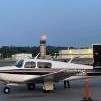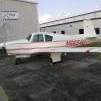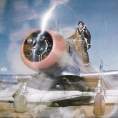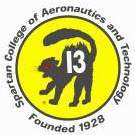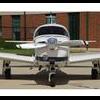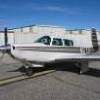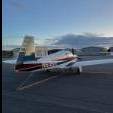Leaderboard
Popular Content
Showing content with the highest reputation on 07/18/2024 in all areas
-
7 points
-
I’m happy to report that enabling the alternate gain settings on the latest software version on my G3X has completely eliminated the porpoising I’ve been dealing with. I took the plane to the avionics shop for my altimeter certification and asked them to use the alternate gain settings we’ve heard about. I was told that I already had the correct version on the G3X but the standard gains were enabled. They enabled the alternate gains settings through configuration mode and on the flight home, the pitch oscillations I had going over were gone. YMMV, but this was the ticket for me.5 points
-
I wouldn’t be in a rush to replace that cable. That fix looks stronger than stock.5 points
-
Yes, leave it be unless there is solid reason to do something. If the leakage is at the rings (by listening through the oil filler tube during a compression test), then there is zero reason to lap valves. It also looks like the compression has been stable for a long time, so if there's no metal in the oil filter or the oil analysis (or not enough to worry about), it's probably fine to just leave it be. When they're like that it's always good to keep an eye on them with oil analysis, borescopes, etc., just to see if the situation changes. A ring flush during the next oil change might help to get some of the compression back. Why do they want to do it? Unless there's a compelling reason to suspect that you have valve guide problems, there's no reason to do this. Do you mean the condensers? If so, then, yes, those should be replaced at mag overhaul, or even at mag iran, imho. They're a wear/failure item. You can do a reasonable job of tube inspection by just loosening the screws around the window sills and sending a borescope down between the interior piece and the outside wall. I've done this a few times and you can get a good representative view of things without taking the panels off if you're worried about that.3 points
-
Some staining is normal there, as well as other places inside the cowl. I just clean the stains off of mine once a year or so. They don't really do any damage. They're just from exhaust leaks at startup before the pipes get hot enough to expand and seal against each other.3 points
-
The swiss-cheese model of error might be over-quoted, but it's for a reason. There are behavioral controls (norming, etc), environmental controls (sterile cockpit, workload mgmt), technical controls (warning systems), procedural controls (checklist discipline, individual and corporate etc). There seems to be a lot of magic-bullet thinking, for example the comment about "technology being the solution". If technology were the answer alone we wouldn't see things like the 737Max8 disasters, which were arguably in significant part an attempt to use technology to make up for human resource shortcomings. I deeply believe in both-and type solutions. I'm nerdily compulsive on my flows and checklists and I'm just a PP. I also enthusiastically bought the Microkit LHS in part for the gear warnings. etc, etc. Also have been spending a lot of thought on procedure, being newer to retracts. So this is all very close to home. The other meta-topic here is shaming. I think generally shame and social norming are under-rated ("I'm ok, you're ok", "you do you", "all truth is relative", blah blah). Many of us just need an ***-kicking from time to time. There are tons of sociological examples of why social norming works. And that can be via positive norms such as ideals of airmanship, professionalism, etc, or negative in not wanting to be "that guy". OTOH human-factors and organizational analytic approaches show that shaming and overly-simplistic norms drive error and its root causes underground. A good case study is the use of checklists in surgery (inspired by aviation). The traditional ideal of the surgeon is essentially to be perfect. There are good reasons for this ethic, but errors inevitably occurred as that ideal is simply unrealistic. Checklists and process controls helped a lot. Some technical controls, too, but people will often do stupid things just because a machine tells them to. Now watch me forget to take out the chocks...3 points
-
I had this happen as well. Fortunately it is easy hand prop to get home so I could fix it in my hangar. Mark3 points
-
I would spend a few thousand on touchup and buffing and call it a day. I wouldn't trade an autopilot that works flawlessly at this time for one that may or may not porpoise like some of the GFC500 installations do. Garmin will get it figured out eventually. The previous owner spent a lot of extra money on the G500 TXi (and probably the GAD43e) to work with the King Autopilot - I would give it some time before you tear the panel apart again.3 points
-
All - I finally sat down with a local attorney today to review the lease agreement. He had a number of concerns with it and I will be addressing those with the airport folks when the time comes. I have this on hold for now until I finish the ppl and get the plane here. Hopefully both of those will be happening soon so that I can focus more on this.3 points
-
There is a philosophical issue here. Some people like to try to get all their maintenance done once a year during the annual. But this often leads to expensive annuals and the airplane being in the shop for weeks waiting for parts and mechanic availability. Others (and I’m firmly in this camp) like to take care of things as they come up and want the inspection to just be an inspection. Certainly if an airworthiness item comes up, it will have to be addressed. But I’d just like a list of the non-airworthiness items so I can address them (or maybe not address them if I determine that to be the prudent decision) at my leisure.2 points
-
My colonoscopies were done by a gastroenterologist at the hospital, not by some fresh-out at a "colonoscopy clinic." Are those a real thing? They sound like a nightmare to me! And my 'scopes were unrelated to, and not recommended by, my FAA Certificated Flight Physician (AME). Nor by my Urgent Care Basic Med doc from the little box They were recommended by my regular doctor, the old "primary care physician." No signs, no symptoms, first age and now family history from dear ol' dad. So I'll keep on getting them, whether I keep flying or sell out and hang up my headset.2 points
-
SB 388 is the 400 hr wobble test to check valve clearance. Lycoming valve guides before 1998 were prone to wear and excessive clearance allows oil to coke on the valve stem and can cause valve sticking. Your call whether to do this or not, but many just wait for “morning sickness” (very rough engine on start up when engine is cold due to sticking valve which clears as engine warms). If the engine was overhauled after 1998, it should have the newer high chrome valve guides and the recommendation is a one time inspection at 1/2 TBO.2 points
-
For the SB 208, you can inspect the bottom of the fuselage tubes (where corrosion is most likely to be) with just the belly panels removed.2 points
-
Entirely my OPINION, and I am NOT an A&P: 1) NO! Leave it be. 2) Yes. I love mine as my belly stays very clean. They are 'controversial', however. Some think the recirculation is bad for the engine. 3) Tough one, but by what you've shared it's pretty unlikely to be anything to do with the valves (no leak sound in exhaust, right?) so lapping seems a wasted effort. Based on history, it doesn't look like it's getting worse...and you've been flying it. Removing cylinders makes me nervous, but at some point you're going to need to. Me, I'd continue flying and keep an eye on compression and oil consumption. 4) Hmm, I know nothing about that SB. Have they done a borescope? How much do they want for the SB? 5) Depends on how many hours on the caps, but I'd want to inspect carefully if >1000 hours. 6) That's SB208. When was the last time it was recorded in the logs? Did you inspect at pre-buy? If no to both, then I'd want to inspect.2 points
-
A MicroKit Landing Height System would have said "Check Gear" at 200 feet AGL. Since that only happens when you are at 200 feet and the gear switch UP, it is not common, so gets your attention.2 points
-
500' Verbalize desired state check in addition to your checklist. "Gear down, flaps down, speed brakes down, on speed, on path" Just like the airlines verbalize, "1000 feet, Gear down, cleared to land". No matter how far or how weird the pattern at some point, you will be a 500'2 points
-
I replaced my no back spring about 4 years ago at 1500 because I had the part, knowing what I know now I woul leave it alone. The risk of the spring failing is minuscule and outweighed by the risk of something being damaged in the installation and/or the new spring failing, if you call Brian Kendrick or Don Maxwell they will probably say the same thing, ain't broke ain't fix it2 points
-
Had to replace that shear pin on the same starter a few years ago. The starter would spin but wouldn't engage the ring gear. Don't recall anything abnormal that precipitated the event. It just sheared. There were two spares RTV'd under the base housing, like you're gonna need these some day. After getting the starter on the bench you'll need to drive the remains of the pin out of the shaft and gear, then press in a new pin. I got lucky that it occurred at my hangar before a pleasure flight, not away from home. Good luck.2 points
-
2 points
-
I have used the Novus level 1-3. Don’t expect miracles, expect to use some elbow grease, but that’s what I would do as well. At least it’s made for plastics…2 points
-
I think everybody should find what works best for them and do that. It's not practical to think that any one method will be optimal for everybody.2 points
-
2 points
-
Actually, there was an accident like that where a noback spring with only a few hundred hours since replacement failed in a Plessey actuator and caused a gear up landing. It was classified as an accident because some structural piece was worn through by contact with the pavement that classified it as substantial damage.2 points
-
Not at all. What if you had a perfectly good no-back-spring and it was replaced with a new one that suffers from infant mortality and snaps in 20 hours? Not always, but Service Bulletins are sometimes over-reactions - a solution looking for a problem.2 points
-
Routinely misinterpreted by people, though.2 points
-
On of the first Mooney specific things I was taught for my 231 was to set the trim to the TOP of the takeoff range. So I didn't need as much strength to pull back once the plane picked up some speed. So it was much easier to hold back to let the plane fly off the Rwy.2 points
-
A Mooney takeoff is much more like a seaplane takeoff than any other landplane I have flown. By this I mean that it cannot always be taken off the ground smoothly by doing anything mechanically -- it must be flown off which requires a fine touch on the elevators. Bob Kromer (former Mooney test pilot) suggests about a 5 lb pull during the takeoff roll and letting the airplane fly off when it's ready. I find this works well on smooth runways and no significant crosswind. However, if the runway is bumpy, a combination of a bump at the wrong time and the stiff landing gear can launch it into the air before it is really ready to fly. So, if I start hitting bumps, I "fly" it with the elevators like I would to keep a seaplane on the sweet spot of the step during a take off slide. If there is a significant crosswind, I don't want it to settle back to the ground in a crab, so I use aileron to help maintain directional control during the takeoff roll and I use the elevators to hold it on the ground a little longer than normal, but not enough to risk wheelbarrowing, and then I pull it off more abruptly so that I'm sure it will keep flying. Once airborne, I level the wings and center the ball and then retract the gear.2 points
-
What I was taught to do in my F (and it sounds like @Shadrach does the same) is apply a steady amount of constant back pressure on the yoke as I approach rotation speed (perhaps starting around 50mph), and hold that steady input until the plane flies itself off the ground on its own. With a calibrated arm, that usually has me lifting off between 65-70, and the plane transitions in to a smooth climb out without much fuss (other than trimming down as speed builds). I think there's probably a sweet-spot amount of pressure where the plane doesn't get too light too early, but still flies off before it wheelbarrows. As the nose wheel gets light, I'll need to apply more rudder (even still on the ground) to keep centerline in a crosswind. On a short runway, I might try to be a bit more authoritative about getting off the ground right around 65 so that I can reduce wheel drag, get the gear up, and accelerate in ground effect as soon as possible. If it's breezy with plenty of runway, I'll keep the elevator input maybe 50% lighter until around 70 at which point I "rotate" with the rest of the usual force, and then the plane flies off with plenty of control in the gusts. @shadrach has a lot more hours in his plane, so if he disagrees, I'd probably choose to emulate him2 points
-
Could be a roll servo or flight computer issue (final amp stage). If it was me I would disconnect the roll servo and put a DC voltage meter across pins D and L. With heading mode and the A/P engaged, heading bug under the lubber line with a level attitude you should have close to 0VDC. Going one way you will have positive DC voltage, and the other way negative DC voltage. The voltage should be equal at 45 deg left and right of the lubber line. This will check the flight computer to see if there is a issue in the final amp stage. If the computer checks good I would send the roll servo out for evaluation. We can evaluate the servo if sent in. Current lead time is 10-14 business days. If you want to send both the roll servo and flight computer I can run them together on the bench.2 points
-
How do we get true mechanical care and skill from our AP/AI community? Are you a quack? Do your customers (me being one) think you are a quack? Or is it maybe we recognize and respect you might be smarter with a wrench than we are and seek your advice? My only advice is don’t let a great skill set in one profession to make you believe you are an expert in another. My situation would have entirely been prevented with colonoscopy at 40/45/50 as recommended. Instead I just went with the ain’t nothing wrong why bother and 52/53 were rough years. Cannot stress enough that Michael Jackson OD’ed on propofol for a reason. It is the best part of a colonoscopy.1 point
-
#3 cylinder issues, makes me wonder about a ring flush. That and valve lapping can make a huge difference. Maybe get some advice from an AP and have them review borescope photos.1 point
-
I'm still wrestling with the question of how best to do this procedure. My understanding is that it's more of an issue on the long-bodies, and the balance seems to be forward a lot of the time in my Acclaim (though I've started purposely loading as far aft as I can on commutes, which just feels better). Techniques I've heard of: -trim into the flare to keep forces low -trim up on the transition but push forward, so trim is set for the flare portion, kind of an alternative approach to the above (you're moving the muscle-y part earlier in the process where you're higher off the ground, almost a reverse flare) -keep trim more moderate and use more force in the flare Pros of more trim: -Weber's law says our perception threshold is 5% of the force we are holding, e.g. so trim to neutral gives much finer feel than 10 lbs of force against a faster trim setting. So much quicker to feel and react to changes in force (feedback from flight surfaces), able to be more precise with force applied, less mentally-distracting Pros of less trim: -Less dangerous on a go-around (the trim is way up for me, to be neutral at 70-75KIAS, and required forward pressure is significant; not crazy but a lot of force and should be applied quickly) -Less risk of tail plane stall. I've felt this about 3 times, once very notably where I had to push forward a bit to stop the bobble. My transition instructor warned me this can set me up for a sudden pitch down and a prop strike. Also, it feels... "not right" to be so close to a limit of primary control authority. Overall I'm seeing better control and awareness with more trim than not, but I'm still very aware of the potential problem. Tips appreciated.1 point
-
Mooneys have the same gear up rate as other GA retractable, but it is an unacceptable rate. We can do better.1 point
-
As long as there are humans in the loop, there will be failures. Increased automation helps in many cases, like the automated reminders, etc., but everybody gets to manage their own risks.1 point
-
Is where we are now really due to a difference in which pre-landing checklist is being used? I guess I'm not sure the issue is GUMPS, or PUFF, or whatever. That is, I doubt standardizing is going to fix the problem. I don't want to admit defeat and flat out agree that 'it is what it is', but it sure seems that way, unfortunately. I don't know if Mooneys are more prone to gear-ups than other retracts. If so, I'd sure want to understand what is so different that would explain it. IMO, the gear-up phenomenon is unique in aircraft incidents...there is some psychology at work that is fundamentally different than other accident chains. It isn't really even a 'chain' of events; more of a memory failure. Personally, I have five points in my approach to an airport environment where I go through my 'gear-down and locked' verification process. I do this because I've accepted that I may forget or be distracted at different places in an unpredictable fashion each and every time I enter the airport area. By having multiple checkpoints I hope to alleviate a gear-up. Occasionally I've missed one, or more, but NOT all of them...1 point
-
1 point
-
If we really wanted to do that sort of thing, I'd say the first 1000 hours of Mooney time have to be with a pilot that already has 1000 hours or more of Mooney time. Pretty lucrative for those of us that already have that! Oh wait, I've only got about 500 hours of Mooney time!!! NOOooooo!!!!1 point
-
I've got to agree with @affricate on this one! You have, by your own post, shiny paint and a working A/P! Save the money for when the plane demands it....trust me, you won't need to wait long1 point
-
I've never liked GUMPS because I always want to put "gear" where the 'g' is, and that screws it all up, unless you do the Gear, Undercarriage, Make sure the gear is down, Probably should check the gear again...etc., version. So now I used PUFFS, Power, Undercarriage, Fuel, Flaps, Seatbelts. Power includes everything for power settings, prop forward if ready, throttle and mixture where you want them, any turbo controls where you want them, etc. Undercarriage is the gear check. Fuel - best tank, pump set, etc. Flaps - I include both approach wing flaps and cowl flaps here. Seatbelts, can include switches if you want, etc. I just find the flow better and I don't jam my mental gears on 'G' doesn't stand for Gear, plus it has an F for flaps, which can include cowl flaps like you suggest. I agree that that needs to be in there, which is one of the reasons I like this better.1 point
-
1 point
-
You are also certainly in the category of people in this group who have questionable mental stability. That’s not an attack or an insult, it’s a well qualified and documented observation.1 point
-
1 point
-
The 5lb-pull will be a different amount of effort for different trim settings, so setting a consistent trim position for takeoff will make a difference there. I've never found takeoffs in my airplane to be very difficult or complicated, but the steady firm-ish pull is a good technique. I don't always bother to get serious about the pull until about 50 kts or so.1 point
-
As the OP of this thread I feel required by law to point out that the thread has drifted quite a bit But nevertheless the new topic of rotation speed is of great interest to me. I take off with the plane configured with the trim and flaps set at the takeoff position. The instructor who checked me out in my M20E recommended that at around 60 MIAS I start to gently pull on the yoke, and then the plane should lift off around 70-75 MIAS. My experience has been less consistent, especially if there is a crosswind component. By pulling off the yoke at 60 MIAS the airplane does get light on all wheels, in the sense that I have quite a bit less directional control (a sideways wind gust can make the plane turn into the wind) and there is a 1-2 seconds period of time when I feel I am not really in control of what is going on. On the other hand, if I try to let the plane accelerate more than 60 before pulling on the yoke, it feels almost as if it is trying to wheelbarrow (mains lifting before the front wheel), which is very disconcerting. So many times I will try to accelerate to 65-70 and then yank it off with a more abrupt pull, but doing this leads to a couple of seconds where the stall horn will intermittently beep, again not something I would like on a normal takeoff. So I'd like some advice on what I am doing wrong.1 point
-
Basically none. Gear ups are baked in to the rates already. Unless there is a macro trend of gear ups per policy written, the the primary things affecting Mooneys will be repair costs, insurance market capacity, and the insurance company's operating expenses.1 point
-
When it’s time, do the autopilot first. Some brackets will need to be riveted to the airplane. That’s sucks when it’s a brand new paint job. Even if the rivets aren’t through the painted skin, it’s a lot of potential wear and tear.1 point
-
1 point
-
I think the FAA got it wrong. Instead or requiring that the gear switch have the shape of a wheel, it should have required it to have the shape of a dollar sign.1 point
-
I am also a fan of keeping ground based nav. There are enough posts about loss of GPS. I flew 18 months with a GTN-650Xi. I hated it so much, I added a GTN-750Xi. For a very good VFR and IFR panel, you can go with 2x G-5, GTN-650Xi and GFC-500 autopilot. I like the GTX-345 for ADS-B Out and In (traffic and weather). If you want to go higher end, replace one of the G-5s with a G-3X touch and you will smile a lot (after you write the check and fly it ).1 point
-
Avidyne 440 is my choice for full function gps nav com. I am a firm believer in keeping ground based nav capabilities.1 point





